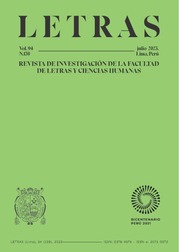The Journeys of Inkarri and the Scene of Encounter: A Reading of Los juicios finales, by Peter Elmore
Abstract
Los juicios finales, Peter Elmore’s latest and most ambitious book of criticism, is a fundamental contribution to the study of the Peruvian cultural and intellectual field in the second half of the 20th century. Based on a meticulous bibliographical reconstruction, the book establishes that the discovery of the Inkarri mythical cycle between 1955 and 1956 originated the most widespread and influential lettered vision of Andean mentalities. The Peruvian intelligentsia postulates indigenous peasants as having mythical roots and messianic projection from this discovery. Los juicios finales analyzes the impact of this vision on the social sciences, literature, and visual arts. In this bibliographic review, in addition to examining each section and chapter, I identify the centrality of two figures for the book’s objectives and organization: José María Arguedas (who was the most creative disseminator of the new perspective on Andean mentalities) and Alberto Flores Galindo (whose thesis on the “Andean utopia” has substantial differences from that of “Andean messianism”). Finally, this bibliographic review comments on some limitations of Los juicios finales, particularly the absence of an intersectional perspective of gender, race, and class that relativizes the scene (invoked in the introduction) of the “encounter between the intellectual and the Andean man.”Downloads
Métricas alternativas
References
Arguedas, J. M. (1956). Puquio, una cultura en proceso de cambio. Revista del Museo Nacional, 25, 184-232. http://repositorio.cultura.gob.pe/handle/CULTURA/772
Elmore, P. (2015). Prólogo a la segunda edición. En Los muros invisibles: Lima y la modernidad en la novela del siglo XX, 2.ª edición (pp. 13-34). Fondo Editorial de la Pontificia Universidad Católica del Perú.
Elmore, P. (2022). Los juicios finales: Cultura peruana moderna y mentalidades andinas. Fondo Editorial de la Pontificia Universidad Católica del Perú.
Flores Galindo, A. (2005 [1986]). Buscando un inca: Identidad y utopía en los Andes: Obras completas III (edición de C. Rivera). Sur Casa de Estudios del Socialismo.
García Liendo, J. (2013). El reflejo y la memoria: Los zorros en la última novela de José María Arguedas. En H. Usandizaga (Ed.), Palimpsestos de la antigua palabra (pp. 137-171). Peter Lang. https://doi.org/10.3726/978-3-0353-0514-2
Lienhard, M. (2012). José María Arguedas: una mirada antropológica. En J. M. Arguedas, Obra antropológica y cultural: Vol. VI (pp. 25-60). Editorial Horizonte.
Manrique Gálvez, N. (1999). José María Arguedas y la cuestión del mestizaje. En La piel y la pluma: Escritos sobre literatura, etnicidad y racismo (pp. 85-98). CIDIAG, Centro de Informe y Desarrollo Integral de Autogestión.
Portugal, J. A. (2011). Las novelas de José María Arguedas: Una incursión en lo inarticulado (2.ª edición). Fondo Editorial de la Pontificia Universidad Católica del Perú.
Ubilluz, J. C. (2009). El fantasma de la nación cercada. En A. Hibbett, V. Vich y J. C. Ubilluz, Contra el sueño de los justos: la literatura peruana ante la violencia política (pp. 19-85). Instituto de Estudios Peruanos.
Ubilluz, J. C. (2021). Sobre el destino incierto del pueblo indio y de su pachakutiy por la vía cultural (Una lectura de “A nuestro padre creador Tupac Amaru” de José María Arguedas). En P. de Lima (Ed.), Golpe, furia, Perú: Poesía y nación (pp. 73-92). Editorial Horizonte.
Vivanco, L. de. (2013). Historias del más acá: imaginario apocalíptico en la literatura peruana. Instituto de Estudios Peruanos.
Copyright (c) 2023 Letras (Lima)

This work is licensed under a Creative Commons Attribution 4.0 International License.
Este obra está bajo una licencia de Creative Commons Reconocimiento 4.0 Internacional



















